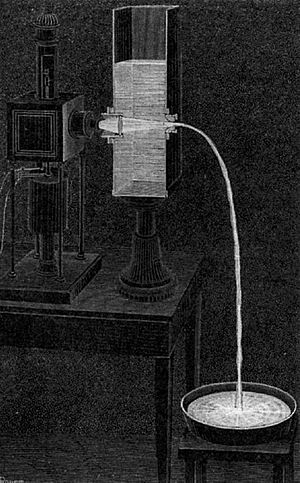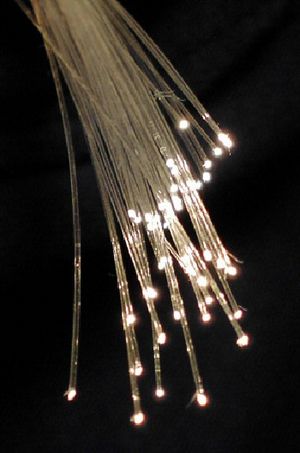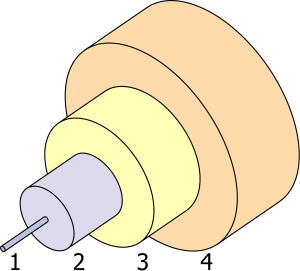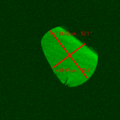Optical fiber facts for kids
An optical fiber is a very thin strand, like a hair, made of glass or plastic. It's special because it can carry light from one end to the other, even around bends! The study of how these fibers work is called fiber optics. It's a cool part of applied science and engineering.
Optical fibers are mostly used for sending information over long distances, like for the internet and phone calls. But they also have other uses, such as for special lighting, sensors (to detect changes), toys, and tiny cameras. Doctors even use them to see inside the human body, for example, down a person's throat.
Contents
How Optical Fibers Were Discovered

The main idea behind fiber optics is guiding light by making it bounce off the inside walls of a material. This is called total internal reflection. Two scientists, Daniel Colladon and Jacques Babinet, first showed this in Paris in the 1840s.
Later, in London, a physicist named John Tyndall also showed this idea in his public talks. He used a stream of water to guide light.
In the 1930s, Heinrich Lamm used this idea for medical exams, to see inside people's bodies. Modern optical fibers, which have a special coating around the glass, came out later. This coating helps the light stay inside the fiber even better.
The name "fiber optics" was created by Narinder Singh Kapany.
A big step forward happened in 1965. Scientists Charles K. Kao and George A. Hockham found a way to make optical fibers much clearer. They realized that tiny bits of dirt in the glass were making the light fade. They suggested using very pure silica glass. This discovery made fibers useful for sending messages over long distances. Charles K. Kao won the Nobel Prize in Physics in 2009 for his important work.
How an Optical Fiber Works
An optical fiber is like a very long, thin, clear tube. It has a center part called the core. Around the core is another layer called the cladding. The core and cladding are made of different types of glass or plastic. This difference makes light travel slower in the core.
When light travels through the core and hits the edge of the cladding at a shallow angle, it bounces back into the core. It keeps bouncing and traveling forward without escaping. This is how light stays trapped inside the fiber until it reaches the very end. If the fiber is bent too sharply or stretched, some light might escape.
To protect the fiber, it has more layers. A plastic coating called the buffer covers the cladding. This buffer helps stop the fiber from breaking if it gets scratched. Often, the buffered fiber is put inside an even stronger outer layer, called the jacket. This makes the fiber very tough and easy to use without damage.
Uses of Optical Fibers
Fiber-Optic Communication
The most important use for optical fibers is in communication. This is called fiber-optic communication. It sends information from one place to another using quick flashes of light through the fiber. The light acts like a carrier wave, and the flashes are changed (or modulated) to carry information.
Fiber-optic communication started in the 1970s. It has completely changed the telecommunications world. It helped bring about the Information Age, where we can share huge amounts of data quickly.
Early fiber systems could only send signals short distances. But newer fibers are much clearer, so light can travel very far before getting weak. This is why optical fibers are used to send phone and internet signals across cities and even between countries. Because they are better than electrical wires, optical fibers have mostly replaced copper wires in major communication networks in many parts of the world.
Most fiber-optic communication systems also use electricity. An electric signal controls a transmitter, which turns the electric signal into a light signal. This light signal then travels through the fiber to a receiver. The receiver turns the light signal back into an electric signal.
Fibers are also used for shorter connections. For example, they can carry sound signals between a compact disc player and a stereo system. These shorter fibers are often made of plastic, which is less clear but good enough for short distances. TOSLINK is a common type of optical plug used for stereos.
Other Uses for Optical Fibers
Optical fibers can also work as sensors. Special fibers change how they pass light when something around them changes. These sensors can detect changes in temperature, pressure, or other things. They are useful because they are small and don't need any electricity where the sensing happens.
These fibers are also used to carry light for people to see. You might see them in decorations, like fiber-optic Christmas trees. They are also used for lighting when it's better to have the light bulb in a different spot than where the light is needed. This can create cool effects in signs and art.

Many fibers bundled together can make a device called an endoscope or a fiberscope. This is a long, thin tool that can be put into small holes. It sends an image of what's inside back to a camera. Doctors use endoscopes to see inside the human body. Engineers use them to look inside tight spaces in machines.
Optical fibers can also be used to make optical amplifiers. These special fibers can boost a light signal as it travels, so it can go even further without needing to be turned into an electrical signal and back. This saves money and makes systems simpler. These amplifiers can also be used to create powerful Lasers, called fiber lasers. They are very strong because the long, thin fiber is easy to keep cool and makes a high-quality light beam.
Images for kids
-
A frisbee illuminated by fiber optics
See also
 In Spanish: Fibra óptica para niños
In Spanish: Fibra óptica para niños




















